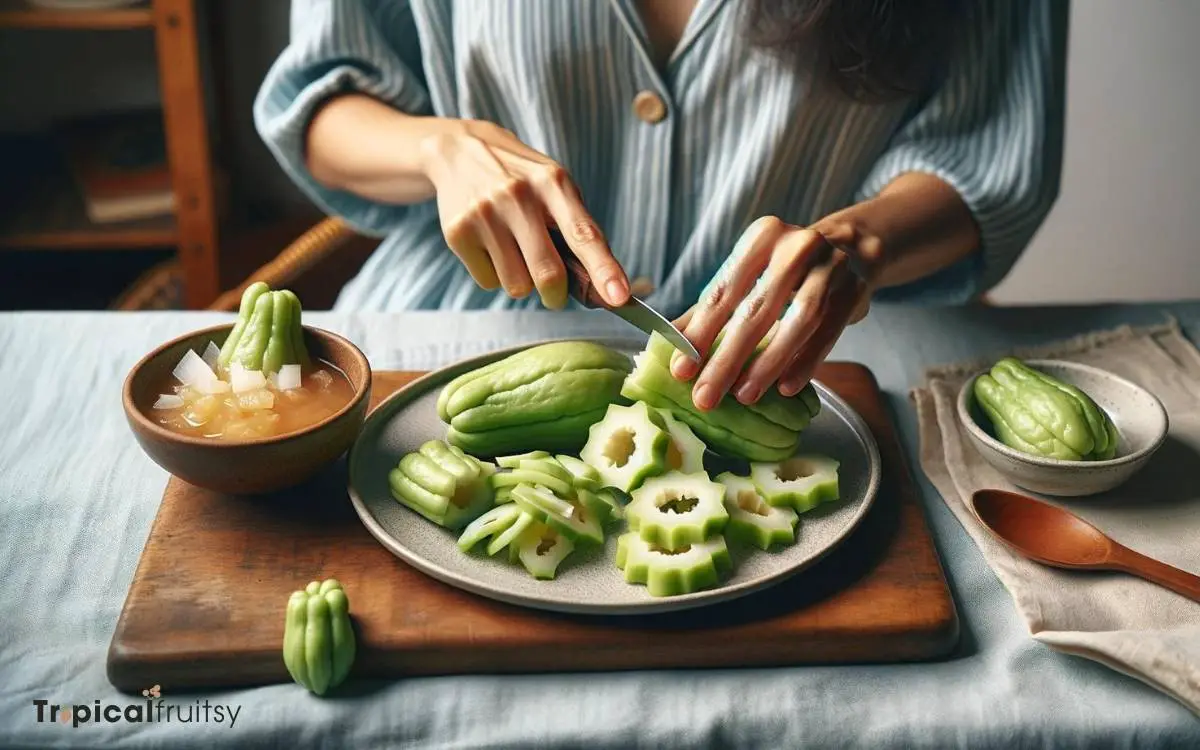How to Eat Chayote Fruit? 6 Easy Steps!
To eat chayote fruit, start by rinsing it under cold water. Cut the fruit in half lengthwise and remove the seed if desired. Chayote can be eaten raw or cooked, and its crisp texture works well in salads, stir-fries, and soups.
Chayote, also known as mirliton or vegetable pear, is a versatile fruit that belongs to the gourd family. It has a mild, cucumber-like flavor and a texture that can range from crisp to tender depending on how it’s prepared.
Here’s how to enjoy chayote in various ways:
When handling chayote, some people might experience a mild skin irritation due to the sap, so wearing gloves is advisable if you have sensitive skin.
Incorporate the mild and crunchy chayote into your diet by adding it to a colorful veggie stir-fry or a refreshing cucumber and chayote salad.

Key Takeaway
Step 1: Selecting the Perfect Chayote
When choosing the ideal chayote for our meal, we must look for firm, unblemished skin and a light green color. This indicates freshness and ensures we’re getting the most nutrients possible.
Chayote is a great source of vitamin C, fiber, and antioxidants, which can support our immune system, aid in digestion, and combat free radicals.
We should also feel the weight of the chayote; it should feel heavy for its size, suggesting a good water content and crisp texture. Avoid those with brown spots or wrinkles, as these are signs of age and potential nutrient loss.
Step 2: Washing and Preparing Basics
After selecting the chayote, we’ll need to wash and prepare it properly to ensure it’s clean and ready for consumption. The skin of chayote can harbor dirt and pesticides, so it’s crucial to handle this step with care.
Here’s how we make sure our chayote is pristine and healthful:
- Rinse the fruit under cold running water, scrubbing gently with a vegetable brush to remove any surface debris.
- Pat the chayote dry with a clean towel to prevent any waterborne bacteria from lingering.
- Peel the chayote if you prefer it skinless, though the skin is edible and contains valuable fiber.
These simple steps help preserve the nutrients and ensure safety.
Step 3: Raw Chayote Serving Ideas
We can enjoy several raw chayote dishes that offer a crisp and refreshing taste to our meals. Slicing it thin, we can add it to salads for a crunchy texture, enhancing our intake of vitamins C and B6.
For a twist, we might marinate chayote matchsticks in lime juice, chili powder, and salt for a zesty, healthful snack that supports our immune system.
Incorporating raw chayote into salsas alongside tomatoes, onions, and cilantro boosts not only flavor but also fiber content, which is beneficial for digestive health.
We could also shred it into slaws or cut it into sticks for dipping in hummus, increasing our protein and nutrient uptake.
Each of these ideas allows us to enjoy chayote’s potential health benefits in diverse and delicious ways.
Step 4: Cooking Methods Explored
Chayote’s versatility extends to cooking, where we’ll find it can be steamed, boiled, roasted, or sautéed to enhance its natural flavors.
Each method offers distinct benefits:
- Steaming preserves most of the chayote’s nutrients, making it a healthful option.
- Boiling is quick and softens the fruit for purees or soups.
- Roasting brings out a richer, more caramelized flavor profile.
When we cook chayote, we’re not just preparing a meal; we’re also preserving its rich array of vitamins and minerals.
The gentle cooking processes like steaming help maintain its vitamin C content, which is essential for immune health, while the fibrous flesh supports digestive wellness.
Step 5: Flavor Pairings and Spices
When we pair chayote with the right spices, we can significantly enhance its nutritional value and flavor.
Citrus notes, for instance, can elevate the fruit’s natural zest while providing additional vitamin C.
Choosing herbs like cilantro or mint not only complements the chayote’s mild taste but also adds a wealth of antioxidants to our meals.
Complementary Spice Choices
Our exploration of chayote’s culinary versatility isn’t complete without considering the harmony of spices that enhance its delicate flavor.
To maximize health benefits and taste, we carefully select spices known for their nutrient profiles and synergistic effects with chayote’s subtle taste.
- Cumin: Offers a warm, earthy note and aids digestion.
- Coriander: Imparts a citrusy hint and contains antioxidants.
- Chili Powder: Adds a spicy kick and boosts metabolism.
These spices not only complement chayote’s flavor but also contribute to a nutrient-dense dish.
We’re mindful of the fact that less is often more; a light hand with these spices allows the chayote to shine while still providing the healthful advantages these spices are known for.
Citrus Flavor Enhancements
Infusing chayote dishes with citrus flavors, we often reach for zesty spices like lime zest or lemon juice to elevate its natural freshness. These citrus elements not only add a vibrant tang but also enhance the fruit’s subtle flavors.
They’re packed with vitamin C, which is essential for immune system function and skin health. When paired with chayote, the combination creates a nutrient-rich dish that’s both delicious and beneficial for our health.
Moreover, we know that certain spices, such as coriander or ginger, can complement the citrusy notes and add depth to the chayote’s profile.
These spices aren’t just about flavor; they come with their own health benefits, including anti-inflammatory properties and digestive aid. It’s all about finding that perfect balance to make the chayote sing on our taste buds while nourishing our bodies.
Herb Pairing Suggestions
Beyond the citrus and spice, we’ll find that herbs like basil, mint, and parsley are perfect companions for chayote, offering layers of flavor that truly complement the fruit’s unique taste.
These fresh herbs not only elevate the taste but also contribute additional nutrients and health benefits.
- Basil: With its sweet aroma, basil adds a refreshing touch and contains antioxidants that support immune health.
- Mint: Mint provides a cool aftertaste and aids in digestion, making it a thoughtful addition to chayote dishes.
- Parsley: This herb brings a clean, slightly peppery flavor and is rich in vitamins A and C, which are vital for maintaining good vision and a robust immune system.
When we incorporate these herbs, we’re enhancing our meals both in taste and nutritional value.
Step 6: Storing Leftover Chayote
After enjoying its versatile flavor, we’ll need to store any remaining chayote properly to maintain its freshness.
Fresh chayote is rich in vitamins and minerals such as vitamin C and fiber, which are best preserved when stored correctly. If we’ve got leftover chayote, it’s important to keep it in the fridge.
Here’s a quick guide for storing chayote:
| Condition | Storage Method |
|---|---|
| Whole, uncut chayote | In the crisper drawer |
| Cut chayote, not peeled | In a sealed container |
| Cut and peeled chayote | In a container with a damp paper towel |
| Cooked chayote | In an airtight container, refrigerated |
Can You Eat Chayote Raw
Yes, you can eat chayote raw. Chayote, a type of squash that is part of the gourd family, is quite versatile and can be consumed both raw and cooked.
When raw, it has a crisp texture similar to that of apples or pears, making it a great addition to salads or as a snack on its own. Some people might peel it before eating due to its slightly tough skin, but the skin is edible as well.
Chayote is not only nutritious, offering a good source of vitamins C and B, folate, and dietary fiber, but it also has a mild flavor that can complement a variety of dishes.
Can You Eat Chayote Skin
Yes, you can eat the skin of chayote. The skin of the chayote is edible, though it’s a bit tougher than the flesh.
Some people prefer to peel it, especially when using chayote in raw preparations like salads, to improve texture and digestibility.
However, when cooking chayote, the skin softens and can be easily consumed, adding a bit of extra fiber to your dish.
The choice to peel chayote or not often comes down to personal preference and the specific recipe you’re following. If you’re trying chayote for the first time, you might want to try it both ways to see which you prefer.
Conclusion
We’ve discovered that chayote isn’t only versatile but also a powerhouse of nutrients.
Did you know that a single chayote contains 17% of the daily recommended vitamin C intake? That’s a compelling reason to include it in our diet.
Whether we savor it raw in salads or cook it to enhance its flavor, chayote is a delightful addition to our meals.
Let’s store it properly to maintain its benefits and keep enjoying this nutritious gem.






